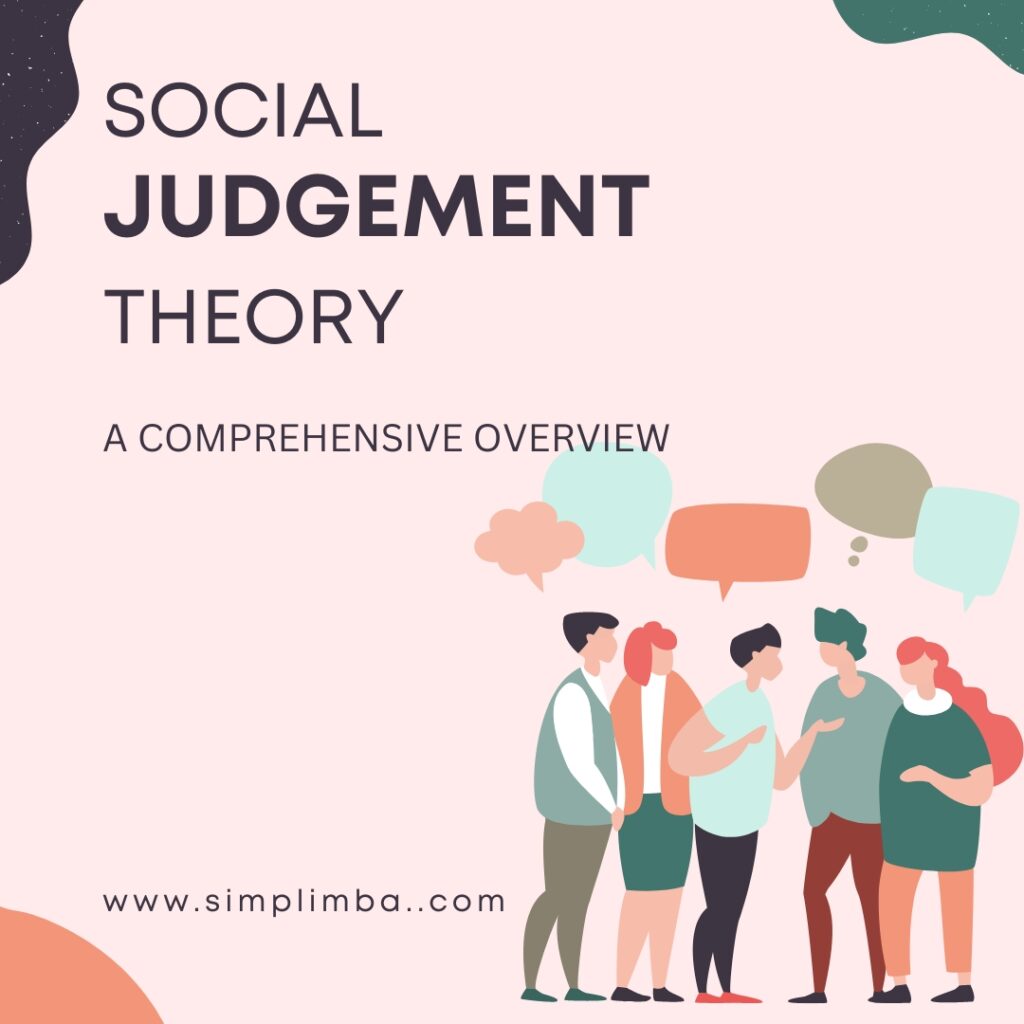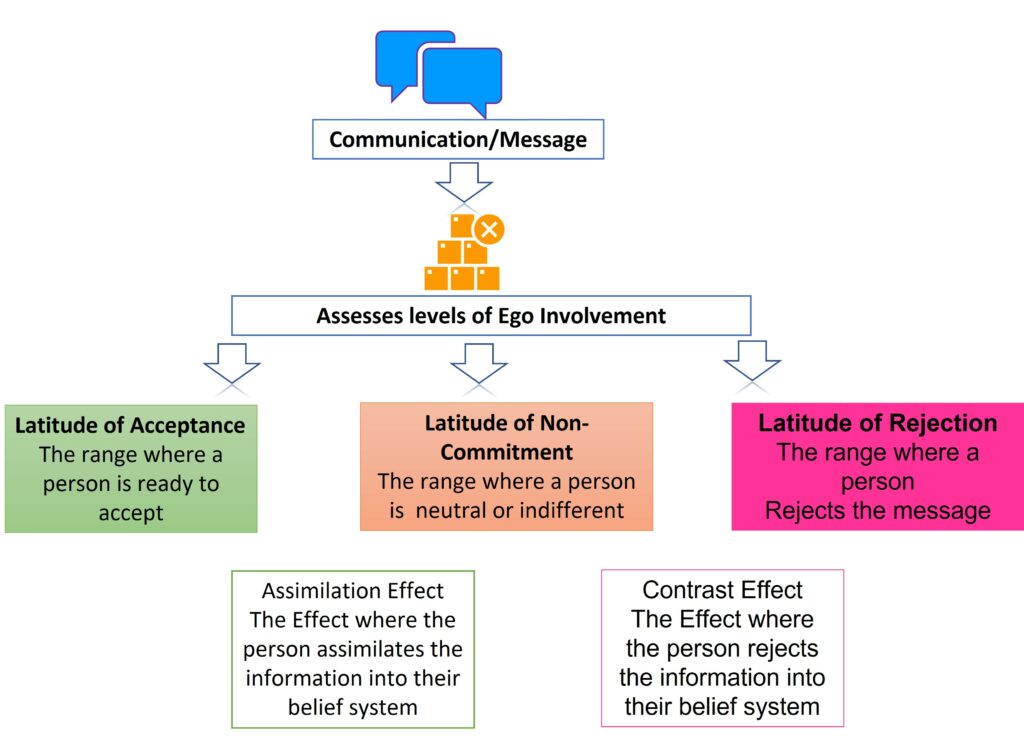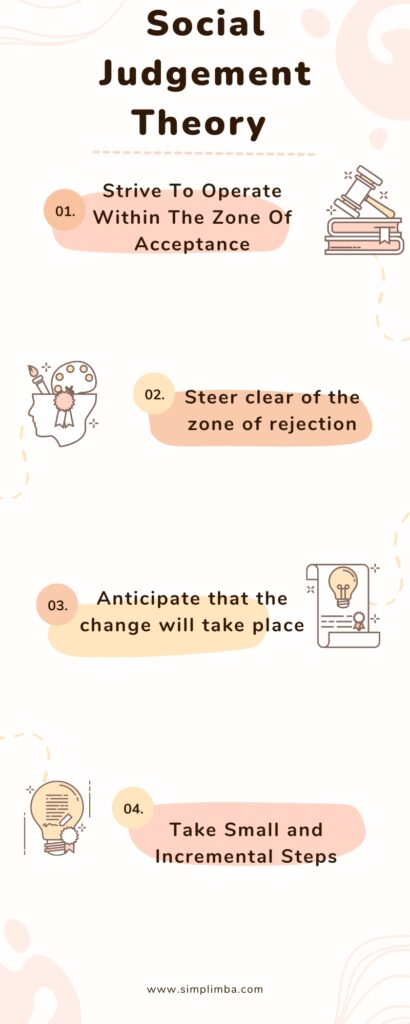
What is Social judgment Theory?
Social judgment theory is defined as the process of evaluating an idea by comparing it to the receiver’s current attitudes. The principles underlying social judgment theory are described in this article. Also, we look at common-rule judgments and persuasive communication messages. In addition, we discuss the role of ego-involvement in social judgments or social judgment involvement approach as they form major components in the social judgment theory
Anchor Distortion
There are some principles of social judgment theory that explain why people make judgments and how they do them. according to Social judgment theory, One of those principles is anchor distortion, which affects the persuasiveness of an incoming message. If a message is too close to an anchor, it will either be assimilated or contrasted and will thus be rejected. However, when an anchor distortion is small or moderate, a message has the highest chance of persuading a person.
Comparison with one’s Attitude/Cognitive Abilities
Another principle underlying social judgment theory suggests that the idea that a person weighs a new idea by comparing it to their own existing attitude scale. This is done subconsciously in the moment of perception. The theory also emphasizes the importance of determining an individual’s own preferred position as an anchor. This is a key element of the process of social persuasion.
Individual Values
Social judgments are influenced by the values of individuals and their environments. For instance, a person may be expected to contribute a certain amount to a charity. When evaluating an individual’s commitment to a cause, a person may use a scale of judgments that ranges from “absolutely not” to “most certainly not”. These positions are called the latitude of rejection and noncommitment.
Social Stereotypes
Social judgments are also influenced by social stereotypes and this is specifically important to understand the social judgment theory. These are beliefs and attitudes about individuals in a certain group. These shared stereotypes reflect a group’s attempt to assess its out-group members. These stereotypes are organized along two dimensions, competence, and warmth. The out-group’s position on these scales depends on its perceived status and degree of cooperation with the in-group. Shared stereotypes can exert negative influences on members of minority groups.

Elements of Social Judgement Theory
Distortion of information by ego-involvement
Ego involvement can lead to the distortion of information in a variety of settings. A common example is parent-teacher conferences, where discussions about the child can lead to ego involvement. A parent may become unreasonable when the teacher mentions something critical about their child. Social Judgment theory asks the sender of the communication to evaluate ego involvement of the reviewer
Common-rule judgments
Social judgments made by common-rule judges have a long history of excluding and marginalizing certain groups. This system is shaped by past decisions of judges, which often shape future rulings. This has had unfortunate consequences for some groups, such as women. However, societal changes have often led to an end to common-rule social judgments.
Persuasive communication messages in Social Judgement Theory
Persuasive communication messages have been used to influence behaviors, particularly in social settings. Researchers have found that people are more likely to accept a persuasive message when the message falls within their latitude of acceptability. However, when it is outside of their latitude, people are less likely to accept the message or engage in the behavior desired. The Social judgment Theory recommends the use of persuasion techniques in the communication
Social judgment theory seeks to identify the kinds and conditions of communication that influence behavior. It studies the effects of persuasive messages on attitudes or desired attitude change, values, and beliefs. Using this theory, researchers can determine which messages lead to changes in behavior and attitudes. As a result, they can develop more effective ways to approach people.
In an experiment, researchers examined how the perceived extremity of a message affects the persuasiveness of an incoming message. In addition, they developed a new attitude structure instrument that would allow for a more refined assessment of the discrepancy between the message and a person’s attitudes. The main dependent variable was the participants’ attitudes toward the use of automobiles in relation to environmental issues. The subjects were presented with a message in the latitudes of acceptance, rejection, and non-commitment.
A persuasive message has a specific purpose: it influences the recipient to take a specific action. It focuses on an aspect of an individual’s life that is important to him or her. This means that it must appeal to their ego or personal values. However, the appeal must appeal to these values and create a positive impact on the receiver.
In addition to its heuristic value, the persuasive appeal is difficult to accomplish. As a result, it is dependent upon a wide range of variables. The most successful persuasive messages are targeted to the receiver’s latitude of acceptance. These messages result in small changes in the receiver’s attitude. These changes can occur over time if several messages are made. Incrementalism is a core idea of the Social judgment Theory
Social Judgement Theory: Attitude change
A social judgment theory describes how people’s prior attitudes mediate persuasion. These theories are based on the assumption that people’s attitudes serve as anchors and standards in their judgments of persuasive messages. These theories also attempt to explain how attitudes can change or persist. Fortunately, these theories do offer a practical plan for changing attitudes.
This process works by using higher levels of mental resources to produce a change in attitude. This change can result from the characteristics of a person’s thoughts, their estimation of good and bad outcomes, or their realization of conflicting beliefs. In some cases, a person’s attitude can be changed without conscious effort.
In the 1950s, behavioral theories on attitude change were developed. These theories reflected classical conditioning and behavioral psychology. They focused on how individuals formed attitudes by interpreting events in their environment. While these theories were helpful in developing more practical theories of attitudes, many researchers did not feel that their work had a direct impact on the procedures used today. In contrast, newer research has focused on the role of multiple modes of processing information and incorporating multiple dimensions.
In order to test the validity of the theory, researchers conducted an experiment to examine the impact of perceived extremity on attitudes and motivations to elaborate on an idea. The experiment had two goals: to test a theory of attitude change and to develop an instrument that would enable a more refined assessment of the discrepancy between a message and an individual’s attitude. The experiment’s main dependent variable was the subjects’ attitude toward the use of automobiles in relation to environmental issues. Subjects were presented with a message at three latitudes: non-commitment, rejection, and acceptance.
According to Kelman, the process of opinion change is a combination of three distinct stages: compliance, identification, and internalization. Compliance involves changing an attitude to obtain a favorable reaction from another individual. However, this change occurs only when the other person is present. Identification is more subtle and occurs on a private level. After identification, the individual’s attitude changes because of the internalization of the external stimulus. This became the central theme of Social judgment Theory
Social judgement theory examples
These are the two real life examples of Social Judgment Theory
- Public Health Campaigns: Public health campaigns often aim to persuade people to adopt healthier behaviors, such as quitting smoking or practicing safe sex. According to SJT, a campaign will be more effective if its messages fall within the audience’s latitude of acceptance or noncommitment.For instance, a campaign aiming to promote physical activity might encounter different attitudes from different individuals. For someone who already exercises regularly, a message advocating for daily exercise would likely fall within their latitude of acceptance. For someone who is sedentary but acknowledges the benefits of exercise, this same message might fall within their latitude of noncommitment. But for a person who strongly dislikes exercise and sees it as unnecessary, the message may fall within their latitude of rejection, and could even cause them to strengthen their resolve against exercise due to the contrast effect.
- Political Campaigning: In politics, candidates often try to persuade voters to support them or their policies. SJT can play a key role here.For instance, if a candidate is trying to promote a progressive tax system, voters who are already in favor of wealth redistribution would likely categorize this policy within their latitude of acceptance. Voters who are undecided or neutral about wealth redistribution might categorize it within their latitude of noncommitment. However, voters who are strongly against any form of wealth redistribution are likely to categorize it within their latitude of rejection. This understanding can help the candidate tailor their messages to different groups of voters.
Implications of Social Judgment Theory

1. Strive to operate within the zone of acceptance, and steer clear of the zone of rejection.
According to the Social judgment Theory, there can be no change within the latitude of rejection because there is no room for it. When new information is introduced into this zone, the receiver either completely stops listening to it or, what’s even worse, responds to it in a manner that is extremely argumentative and negative. A disinterested or hostile listener is the very last thing a persuasive speaker wants to have on their side. According to the Theory, this means that direct attacks are almost always destined to be unsuccessful.
The endeavor that lies ahead of us is challenging, but it is also very achievable. We need to locate a point of agreement so that we can move forward with this endeavor. We have no choice but to operate within the latitude of acceptance or, alternatively, the latitude of non-commitment. The most effective strategy for locating these latitudes is to communicate with one another and pay close attention to the information provided by our receivers.
We have written in detail about many communication theory. Read here
2. Anticipate that the change will take place over a protracted period of time and involve a large number of incremental steps.
There are three circumstances in which influence is most likely to take place. To begin, we have to operate within the bounds of acceptable behavior. Second, we have to make it so that the new position is significantly different from the anchor position in some way. Third, we need to steer clear of the effects of assimilation and contrast. Because of these three factors, our effectiveness, both in the short term and the long term, is obviously reduced. It is absurd to expect miracles of influence in which the people we are trying to persuade immediately and dramatically alter their behavior.
3. Be wary of getting involved with your own ego.
The conference between the parents and the teachers is the perfect illustration of this risk. When it comes to certain parents, the ego gets very involved whenever the topic of conversation centers on their child; it’s like a switch being flipped. When the instructor says anything that even remotely sounds critical of the child, normally reasonable people have a tendency to become extremely unreasonable.
According to the Hypothesis, we are aware of what is taking place. The child is a matter that involves one’s ego. Right now, we are dealing with individuals who have narrow latitudes for acceptance and broad latitudes for rejection. As a result, virtually everything that the instructor has to say is almost certainly going to be deemed unacceptable. If anything the teacher says is distorted by the parents, it is more likely to be a contrast than assimilation. This is because the contrast is easier to understand than assimilation. Because of this contrast, the parents will perceive the comments made by the teacher to be significantly more negative than they “really” are.
Of course, not only parents but also other people can fall prey to this way of thinking; it’s not exclusive to them. You can see it in the people you hang out with. Make negative comments about a friend’s family members, such as their parents or siblings. Make fun of their very close friends. Make fun of the way that they want to wear their hair or clothes by making fun of them. Egocentric behavior is immediately obvious at first glance. You have crossed a significant line, and from this point forward, you are no longer dealing with people who are reasonable.
Social Judgment Theory: Implications in Modern Day context
From Marketing to winning political elections, the Social Judgement theory finds its relevance almost everywhere. Marketers try to bring incremental changes to your usage pattern rather than bringing a radical change. For example, to change breakfast behaviors, the marketers instead of introducing new cereal every year, bring new and incremental changes (like adding dry fruits and lessening sugar)
On similar grounds, politicians try to win elections from the context of placing newer beliefs in the zone of acceptance rather than in the zone of rejection. These things or particular attitude are perceptible in a setting of democracy where elections take place every four to five years. A belief that has been largely ingrained in the culture or historical beliefs will be removed incrementally and slowly rather than taking radical steps. These steps will mostly by the social judgment theory.
Conclusion
We find that social judgment theory finds its relevance in almost every aspect of human psychology as human beings live in society. For any changes to be successful in the public domain, it is imperative to cater to certain elements of the theory. In a corporate setup, radical changes to employees’ way of working are generally unsuccessful. The theory finds its usage in the case of new mergers and acquisitions and finding a cultural fit in a new acquisition.
Samrat is a Delhi-based MBA from the Indian Institute of Management. He is a Strategy, AI, and Marketing Enthusiast and passionately writes about core and emerging topics in Management studies. Reach out to his LinkedIn for a discussion or follow his Quora Page
